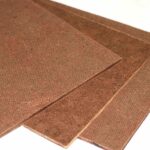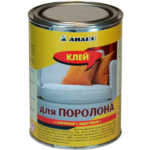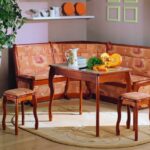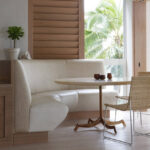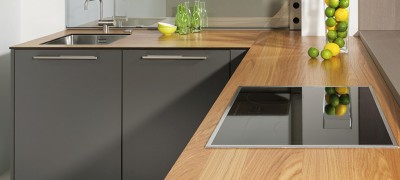Do-it-yourself kitchen upholstery
The kitchen is considered one of the most visited places, so furniture upholstery often wears out faster. The frame made of MDF can last for several more decades, so it is inappropriate to throw furniture away due to worn-out fabric.

Finding a replacement for a kitchenette is also often difficult. It fits perfectly into the interior, occupies a certain place, does not bother anyone. The only way out is to cover the kitchenette with a new fabric. Such repairs will help restore furniture and extend its service life.

Do-it-yourself furniture restoration is much cheaper than purchasing a new set. In this case, there are a large number of options when choosing an upholstery material and filler.
Other benefits of self-upholstery:
- the choice of fabric;
- the possibility of repairing the frame;
- saving money on hiring workers.
The main disadvantage of self-cladding is a certain complexity, certain skills are required.
Selection of fabric for the waist of the kitchen corner
Replacing the upholstery material with another should be done without haste. It is recommended to choose the fabric and filler in advance, there should be no problems with the choice of upholstery. Non-staining wear-resistant materials are more suitable for the kitchen. Using leatherette will help create expensive designs.

Suitable types of fabric for upholstery of the kitchen corner:
- tapestry - characterized by density, durability, the material retains its original appearance for a long time, a variety of tones and colors allow you to choose an option for any interior;
- velor - strength is considered the main advantage, fabric with dense pile looks stylish, over time the pile can wear off, as a result the upholstery does not look very presentable;
- flock - dense material is durable, waterproof impregnation simplifies the maintenance procedure;
- jacquard - looks stylish, not suitable for the kitchen due to rapid wear;
- PU leather - by its characteristics it resembles natural leather, is characterized by wear resistance, heat resistance, elasticity, ideal for upholstery of kitchen furniture;
- eco-leather - polyurethane base provides such characteristics as elasticity, safety, hypoallergenicity, softness;
- PVC leather is considered the most popular material due to its affordable cost, the fabric is elastic, easy to care for, the only drawback is the release of harmful vapors into the atmosphere.
If necessary, you can also choose natural leather for upholstery; regular maintenance will help keep the material in proper shape for many years.

Important! Furniture with natural leather upholstery should not be placed near heat sources, this will help prevent premature wear.When leaving, it is recommended to use special detergents, they should not violate the integrity of the coating.
What tools are needed
To restore the kitchenette, you will need the following tools:
- a knife or screwdriver for removing old staples; in the professional field, a staple remover is used;
- hammer;
- painting or stationery knife designed for cutting foam rubber;
- keys used to disassemble the frame of the corner before the final completion of the reconstruction of the upholstery;
- sewing machine - used to sew new upholstery;
- furniture cardboard - provides high-quality, even stitching of the upholstery;
- stapler for staples - with the help of them, the fabric is attached to the frame;
- fittings - designed for additional decor;
- glue - used for attaching foam rubber.
The process of constriction and restoration
The furniture pull can be carried out in one day. To do this, you should worry about materials and tools in advance. Padding of furniture does not require special skills or education. When carrying out work, you should be careful and restrained, patience will not allow you to quit what you started in the middle of the path. Before starting work, it is necessary to think over the work algorithm and strictly follow it.

Attention! Before pulling the kitchen corner, it must be carefully disassembled into separate parts. Disassembly is carried out in parts, all elements must be carefully laid out, not thrown away until the upholstery is completed.
Removing old upholstery
Care is advised when removing old upholstery. You should prepare in advance for the need to remove old brackets, the number of which can reach hundreds or more. When removing staples, it is recommended to use a screwdriver, pliers, sometimes a clerical knife may be required.

To speed up the restoration will help to pry off all the staples and remove them. This approach will help you avoid wasting time changing tools. It is recommended to put the staples in a garbage bag immediately, this will help to avoid accidental injury.
Care is advised when removing fasteners to ensure that the fabric remains intact. Old pieces of fabric should be used as templates when cutting new upholstery.

A filler is located under the fabric, most often it is foam rubber or other materials.
Preparation of materials
The new woven pattern should match the old one exactly to avoid problems. It is recommended to use a bar of soap or chalk when marking. Adding 5 cm around the edges is required for seams. When using dense fabrics, add another 2 cm each, this will help to avoid strong tension on the frame. When buying fabric, you should make calculations in advance and add a certain amount just in case. The leftover fabric can always be used to upholster the stools of chairs. You can always sew small pillows if needed.

Sewing ready-made patterns is carried out on a sewing machine. Several seams will help to increase the strength, this will help prevent them from diverging in the future.
Foam rubber is used as a filler. It absorbs odors, so it is recommended to use a new one when replacing the upholstery. The calculation of foam rubber is carried out in the same way - the measurement of the old one is carried out. The thickness depends on the type of furniture.

We repair the frame of the corner
All frame elements that have become unusable must be replaced.When carrying out work, it is important to observe accuracy, observe accurate markings. Legs with peeled coating must be cleaned of dirt and dust, sanded. All cracks, gaps, delamination must be filled with wood glue.

Adhesion strength is achieved due to clamps, which press down the contacting elements. The frame is primed, after which it is painted or varnished. Fastener holes are drilled to hold the filler in place.
Tighten with new fabric
The constriction process consists of the following stages:
- attach the foam rubber to the frame with staples or glue;
- place the cut fabric face down, lay the structural element on top;
- pull the fabric neatly from all sides to the center, avoiding distortions;
- fix with a stapler around the perimeter in increments of 40 mm.

Important! If the material is thin or the structure is complex, a carriage tie is used when tightening. Special furniture nails are used as fasteners. This approach allows you to extend the service life of the restored corner.
Putting it all together
The assembly is carried out in the reverse order of parsing. All mounting holes must be pre-drilled. The complexity and duration of the work depends on the type of construction. Folding elements are fixed with hinges. After that, the structure is attached to the pallet, and the supports are mounted to it. At the next stage, the backrest and seat are installed, first to the first sidewall, then to the second. At the final stage, the legs are installed.

The updated corner will help to freshen up the interior of the kitchen without serious investment. Covers will help extend the life of the new upholstery.

Video: hauling a kitchen corner with furniture fabric









